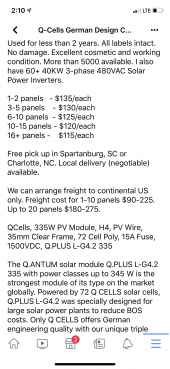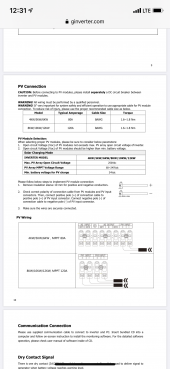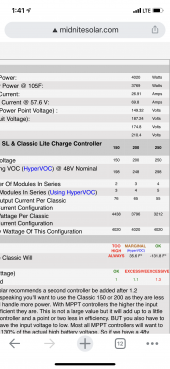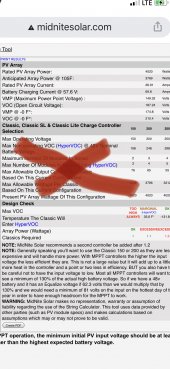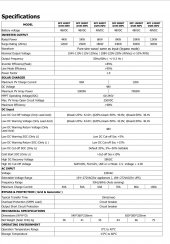You are using an out of date browser. It may not display this or other websites correctly.
You should upgrade or use an alternative browser.
You should upgrade or use an alternative browser.
New wondering if this is a good deal
- Thread starter Jgb3
- Start date
MisterSandals
Participation Medalist
MPPT range is 60-245 with a max of 250v so i'd shoot for ~200Voc for the array.
48.6Voc would make 4 in series very good. Then parallel as many as you care to fuse and wire (for increased amps).
Do you have a feel for how many panels you want/need?
48.6Voc would make 4 in series very good. Then parallel as many as you care to fuse and wire (for increased amps).
Do you have a feel for how many panels you want/need?
Steve_S
Offgrid Cabineer, N.E. Ontario, Canada
Q.Cells are Top Notch panels, they are Premium Tier-1. You have 72 Cell & 60 Cell formats, For the price that IS good (look up the MSRP ouch).
72 Cell panels are BIG many are also Bi-Facial, I don't know if these are, as both can be had as Mono-facial or Bi-Facial. Unless you have a Light Background and are "ready" for Bi-Facial there is little point. Bi-Facials are quite popular when used for Carports or Shading areas where the ground surface can be a light colour to reflect the light back. I've seen a few of those done and they look quite nice, many examples on the web too.
The GW AIO's are good kit, but look at the power consumption (powersave mode is likely not something you'll use) for standby.
PowerSave uses voltage pulses to determine if anything wants power so that it can wake the inverter. If you have LED lights at <15W, they will "blink" because it's not enough draw to Wake up the inverter... a Fridge, Pump or something similar will have enough draw demand to wake it up. Powersave is GOOD for when you are away from the house but want to keep fridge etc running. The wake threshold varies between Inverter models, so check docs.
Careful on Sizing Inverter as well... Undersized is Never Good obviously But too oversized and you gain other issues.
But too oversized and you gain other issues.
A 24V system can support up to 6000W and a 48V system can support 12,000W (excluding Surge Capacity)
6000W ÷ 120VAC = 50A or 240V/25A
BTW: Midnite Solar has a Sizing Calculator for Solar Panels for their products. BUT, you can use the tool to figure out the various Series/Parallel combo's to provide the total Volts, Watts & Amps figures. Their software recommends whatever Classic would fit, you can ignore that part and just use it for the "Fast Math" and juggling panel configs for optimal output.
Check it out here.
72 Cell panels are BIG many are also Bi-Facial, I don't know if these are, as both can be had as Mono-facial or Bi-Facial. Unless you have a Light Background and are "ready" for Bi-Facial there is little point. Bi-Facials are quite popular when used for Carports or Shading areas where the ground surface can be a light colour to reflect the light back. I've seen a few of those done and they look quite nice, many examples on the web too.
The GW AIO's are good kit, but look at the power consumption (powersave mode is likely not something you'll use) for standby.
PowerSave uses voltage pulses to determine if anything wants power so that it can wake the inverter. If you have LED lights at <15W, they will "blink" because it's not enough draw to Wake up the inverter... a Fridge, Pump or something similar will have enough draw demand to wake it up. Powersave is GOOD for when you are away from the house but want to keep fridge etc running. The wake threshold varies between Inverter models, so check docs.
Careful on Sizing Inverter as well... Undersized is Never Good obviously
A 24V system can support up to 6000W and a 48V system can support 12,000W (excluding Surge Capacity)
6000W ÷ 120VAC = 50A or 240V/25A
BTW: Midnite Solar has a Sizing Calculator for Solar Panels for their products. BUT, you can use the tool to figure out the various Series/Parallel combo's to provide the total Volts, Watts & Amps figures. Their software recommends whatever Classic would fit, you can ignore that part and just use it for the "Fast Math" and juggling panel configs for optimal output.
Check it out here.
MidNite Solar - Classic Sizing Tool.
MidNite Solar is the industry leader and manufacture of quality Renewable Energy System electrical components and E-Panels.
www.midnitesolar.com
Steve_S
Offgrid Cabineer, N.E. Ontario, Canada
Yep, as you see the PV ARRAY figures are what you are after.
If you play with the combos of setting the panels in Parallel & Series you can tweak it to get the best layout to provide the required Volts, Amps & Watts to the system you want to use.
If you play with the combos of setting the panels in Parallel & Series you can tweak it to get the best layout to provide the required Volts, Amps & Watts to the system you want to use.
MisterSandals
Participation Medalist
5 in series is too much. Just a few degrees below rated temp (25 deg C) and they produce over 50Voc each. That is the one number to never exceed lest you let the magic smoke out.I was gonna do 5 in series 20 panels total is that to much? I’m in the mountains in South Carolina
Conversely, 5 strings of 9.45amps (~40amps total ) is quite a to deal with too in terms of wire size and fusing.
An SCC that takes higher input volts will likely be easier to match an array to. Might even be cheaper depending on the length of your wire run from array to SCC.
I haven’t bought a charge controller yet. I like the all in one units. Is there something better then the growatt? My array will be away from the house, probably a few hundred feet. I have 32 280ah grade A lifepo4 cells on there way and 2 over sized Daly bms. I will probably get the q cell panels since I can pick them up. Any input on the rest would be appreciated.5 in series is too much. Just a few degrees below rated temp (25 deg C) and they produce over 50Voc each. That is the one number to never exceed lest you let the magic smoke out.
Conversely, 5 strings of 9.45amps (~40amps total ) is quite a to deal with too in terms of wire size and fusing.
An SCC that takes higher input volts will likely be easier to match an array to. Might even be cheaper depending on the length of your wire run from array to SCC.
MisterSandals
Participation Medalist
Yes, i consider the growatt an economy brand.Is there something better then the growatt?
If you want premium quality and often well warrantied, i'd look at:
Morningstar, Outback, Schneider and Victron (that's in alphabetic order to hide my biases/experience). I am sure others can add to this list.
With a wire run of several hundred feet, the cost of wire will definitely come into play. To reduce wire size requirements, you should maximize the voltage. 600v i believe is near the top end from what i've seen.
Good read:

Schneider Electric Conext XW MPPT 100-600 best use
Trying to come up with the best way to deploy this Schneider Electric Conext XW MPPT 100-600 charge controller. It has a capacity of 100 amps and 600 volts. I ohmed out the PV connectors, they are all common. So if I have two or three series strings of PV panels, connecting them to the charge...
Found the Schneider thread here:

Search results for query: best solar charge controller
MisterSandals
Participation Medalist
Here is a monster thread that details the installation of a large LiFePO4 system like you are planning:

 diysolarforum.com
diysolarforum.com

Sixtysix 280ah Cells from Deligreen
My 66 Deligreen EVE cells arrived today in 17 boxes I am happy to say that the boxes are in pretty good shape. One box was opened by customs. I opened that one and another one so far. One thing I noticed is a "Made in China" sticker right on top of each cell. I am happy to report that they...
So I could run the Schneider 600v along with my growatt 12k and use the growatt as inverter ac power and additional panels(if I get to a place I can have a closer array) and use the Schneider as my large array charge controller ????Yes, i consider the growatt an economy brand.
If you want premium quality and often well warrantied, i'd look at:
Morningstar, Outback, Schneider and Victron (that's in alphabetic order to hide my biases/experience). I am sure others can add to this list.
With a wire run of several hundred feet, the cost of wire will definitely come into play. To reduce wire size requirements, you should maximize the voltage. 600v i believe is near the top end from what i've seen.
Good read:

Schneider Electric Conext XW MPPT 100-600 best use
Trying to come up with the best way to deploy this Schneider Electric Conext XW MPPT 100-600 charge controller. It has a capacity of 100 amps and 600 volts. I ohmed out the PV connectors, they are all common. So if I have two or three series strings of PV panels, connecting them to the charge...diysolarforum.com
Found the Schneider thread here:

Search results for query: best solar charge controller
diysolarforum.com
MisterSandals
Participation Medalist
Sounds reasonable off hand. I am not familiar with the Schneider or growatt so i recommend drawing it up and posting it for a review or more questions. Its really not my area of expertise and there are many here with tremendous knowledge and experience with what you're doing.So I could run the Schneider 600v along with my growatt 12k and use the growatt as inverter ac power and additional panels(if I get to a place I can have a closer array) and use the Schneider as my large array charge controller ????
Some quick math for 20x 49v panels...
10x in series is 500Voc
2 arrays is 19amps.
Looks like 8awg or 10awg (see assumptions in pics)

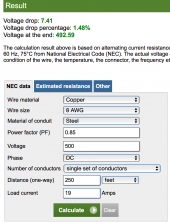
MisterSandals
Participation Medalist
MisterSandals
Participation Medalist
Too much info is cropped so i cannot tell what its says exactly.Can I over panel as long as the volts stay low? This would be one of 2 channels says 7000watt max 250v
You always need to stay below the max input voltage. Over panelling is often a good strategy to maximize the SCC during low sun periods (early ,morning, late afternoon and overcast days).
Hedges
I See Electromagnetic Fields!
- Joined
- Mar 28, 2020
- Messages
- 20,535
@Hedges is a big array guy, maybe this will conjure him and his insights with SunnyBoy equipment (also high quality and missing from my notes).
I can't hear the "@" sign. Just stumbled onto this thread.
5 in series is too much. Just a few degrees below rated temp (25 deg C) and they produce over 50Voc each. That is the one number to never exceed lest you let the magic smoke out.
Conversely, 5 strings of 9.45amps (~40amps total ) is quite a to deal with too in terms of wire size and fusing.
An SCC that takes higher input volts will likely be easier to match an array to. Might even be cheaper depending on the length of your wire run from array to SCC.
One of the images shows 80A PV input, so 4s5p for 200 Voc, 50A seems reasonable.
Some 4s strings can orient towards sun at different times of the day, reducing peak power and increasing hours of production.
SMA Sunny Boy is one of the top-quality high voltage string GT PV inverters. I've used them about 17 years, with about 35 years MTBF (two failures out of 5 units in that time). One was repaired in warranty during its first 5 years. After decades, more practical to swap in new models, or used or new-old-stock rather than repairing.
You can use some GT PV inverters in an off-grid setup if they play nice with battery inverters (implement frequency-watts).
The high-voltage strings work well for single string into an MPPT (any shading activates bypass diodes.) If multiple strings in parallel, small amount of shading is OK but 33% to 50% shading of one string causes additional power loss, not running other panels optimally.
There are high voltage SCC as well, but they tend to cost more per watt than lower voltage SCC. Maybe due to what it takes to charge a 48V battery from PV that is 5x to 10x as high voltage. So I find AC coupled PV more cost-effective than DC coupled.
So I could run the Schneider 600v along with my growatt 12k and use the growatt as inverter ac power and additional panels(if I get to a place I can have a closer array) and use the Schneider as my large array charge controller ????
Will your battery be so large, and at such a low SoC, that GroWatt can't recharge it in a day? Do you need higher charge rate by adding a separate charge controller?
I think Growatt supports AC coupling.
If you DC couple, does Growatt have a way to know battery state of charge? For my Sunny Island, a battery shunt would be the answer.
How much is the Schneider 600V? Looks to me like $1400 for 6kW

Schneider Conext MPPT 100 600V Charge Controller
Designed for large DC coupled solar/storage systems, the Conext MPPT 100 600V solar charge controller can output 6kW and offers easier, cheaper installation.
I can find recent model Sunny Boy GT inverters around that price. Older models I've bought cheaper, around $100 per kW.
If Growatt does frequency-shift to manage GT inverters, then Sunny Boy, Enphase, and others could be used.
Growatt has a maximum AC output in the 8kW or 9kW range. With AC coupling you might be able to have several kW more while the sun shines, good for running A/C and the like.
Similar threads
- Replies
- 2
- Views
- 176
- Replies
- 7
- Views
- 1K
- Replies
- 12
- Views
- 544
- Replies
- 11
- Views
- 245
- Replies
- 2
- Views
- 217



